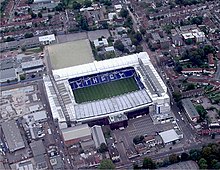Tottenham Marshes
Tottenham played their first matches at Tottenham Marshes on the available public pitches and remained there for six years. It was at this ground that Spurs first played arch rivals Arsenal (then known as Royal Arsenal). Spurs were winning 2-1 until the match got called off due to poor light after the away team arrived late.[1] There were occasions on which fights would break out on the marshes, in dispute of the teams that were allowed to use the best pitches. Crowds were increasing and a new site was needed to accommodate these supporters.
Northumberland Park
In 1898 the club moved from the marshes to Northumberland Park and charged an admission fee of 3d. They only remained at this ground for a year as in April 1899 14,000 fans turned up to watch Spurs play Woolwich Arsenal. The ground was no longer able to cope with the larger crowds and Tottenham Hotspur were forced to move to a new larger site. They moved 100 yards down the road to their current ground.
White Hart Lane
White Hart Lane was originally a disused nursery owned by the brewery Charringtons and located behind a public house. The landlord realised the increased revenues he could enjoy if Tottenham played their matches behind his pub and the club moved in. They brought with them the stand they used at Northumberland Park which gave shelter to 2,500 fans. Notts County were the first visitors to 'the Lane' in a friendly watched by 5,000 people and bringing in £115 in receipts, Spurs won 4-1. QPR became the first competitive visitors to the ground and 11,000 people saw them lose 1-0 to Tottenham.
In 1905 Tottenham raised enough money to buy the freehold to the land and became the permanent owners of the ground. As the club grew new stands were added. A new main stand was added in 1909, the East stand was also covered this year and extended further two years later. The profits from the 1921 FA Cup win were used to build a covered terrace at the Paxton Road end and the Park Lane end was built at a cost of over £3,000 some two years later. This increased the ground's capacity to around 58,000 with room for 40,000 under cover. The East Stand development was finishing in 1934 which increased the capacity to around 80,000 spectators and cost £60,000. The pitch was renovated in 1952 which uncovered a number of items from the old nursery on the site and one year later the first floodlights were introduced. These lights were upgraded in 1957 which required the cockerel to be moved from the West Stand to the East and then in 1961 floodlight pylons were installed.
The West Stand was replaced by an expensive (and far behind schedule) new structure and the stadium started its long modernisation process. Various developments and upgrades were implemented over the years and in 1992 the lower terraces of the south and east stand were converted to seating and the whole of the North stand followed to become all-seater the following season. The South Stand re-development was completed in March 1995 and included the first giant Sony Jumbotron TV screen for live game coverage and away match screenings. The capacity of the stadium increased to just over 33,000. In 1997/98 season the Paxton Road stand had a new upper tier added which included the second Jumbotron screen and increased capacity to 36,240 and was funded by a rights issue in 1996.[2]
Minor amendments to the seating configuration were made in 2006 bringing the current capacity of the stadium to 36,310.
Future plans
Tottenham are currently seeking a larger stadium. Originally it was thought that the team may move to a new site. One possibility for the club was the use of the area where the Olympic Stadium is going to be built after the London 2012 Olympics, although this would have involved a move out of Tottenham and the plan was dropped because the stadium will retain a running track.[3]
The club stated in 2007 that it would announce its preferred option in the first half of 2008, but delayed this decision until the autumn.[4] In April 2008 it was revealed in the press that investigations were taking place into the possible use of the adjacent Wingate industrial estate. If planning permission and the agreement of the current businesses there was granted, a 55-60,000 seat stadium could be constructed on the current White Hart Lane site.[5]
In October 2008, the club announced that, if approved, it was planning to build the new stadium just to the north of the existing stadium at White Hart Lane, with the southern half of the new stadium's pitch located on the northwest corner of the Lane. The unique design of the build would allow the new stadium to be built adjacent to White Hart Lane as the old facility continues to be used for the team. During the summer after two thirds of the new stadium was complete, the northern and western stands would be demolished and a new pitch laid. The rest of the stadium would be built in the years to follow. If it is built, club chairman Daniel Levy has stated that it will not adopt the White Hart Lane name, but will instead be named after a sponsor.[6]London Development Agency, who worked on development of Arsenal's Emirates Stadium, is reportedly leading the development of the plans for the new stadium.[7] In December 2008, the design for the new stadium, by KSS Design Group and Buro Happold was revealed.[8] A projected completion date was predicted on 26 October 2009, as Spurs' chairman Daniel Levy stated that Spurs intend to move into the partially-built new stadium for the start of the 2012-13 season, with the final 56,250-seat venue ready for the following campaign.[9] Tony Winterbottom, formerly of the







Comments
0 comments to "Tottenham Hotspur FC - Stadium"
Đăng nhận xét